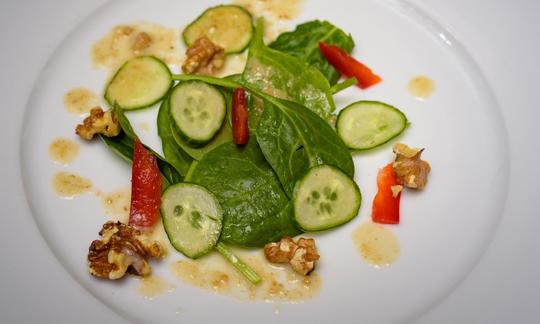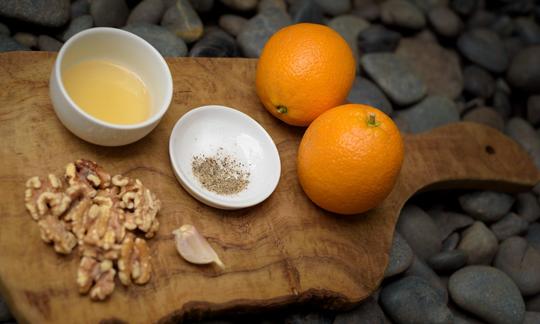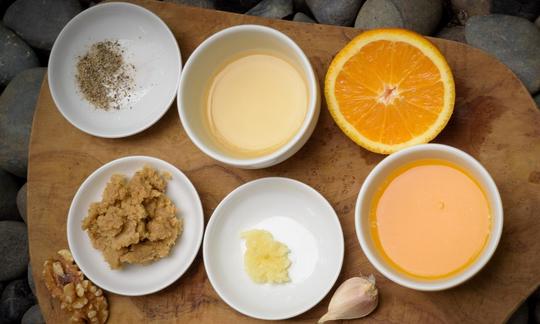Oil-Free Vinaigrette with Walnuts and Orange Juice
vegan
Ingredients (for servings, )
| 1 ⅞ oz | Walnuts (tree nuts), raw (organic?) |
| 80 ml | Orange juice (raw?, organic?) (2.9 oz) |
| 1 clove | Garlic (organic?) (0.11 oz) |
| 6 tbsp | Balsamic vinegar, white (Condimento bianco, organic?, raw?) (3.4 oz) |
| 1 dash | Salt, table salt (0.01 oz) |
| 1 dash | Black pepper (organic?, raw?) (0.00 oz) |
Equipment
- coffee grinder, electric
- citrus juicer (lemon squeezer)
Type of preparation
- food preparation without heating
- blend
- squeeze
Preparation
Preparing the ingredients
Finely grind the walnuts in a coffee grinder until they have the consistency of a nut butter. You may need to run the coffee grinder a few times to get the consistency fine enough.Squeeze the oranges. Measure the amount of juice required for the dressing.
Peel the garlic and mince using a garlic press.
Finishing the vinaigrette
Blend the prepared ingredients together with the balsamic vinegar. You can thin the dressing with water to the desired consistency. Season with salt and pepper to taste.If you leave the vinaigrette to stand for a while, it will thicken a little.
|
Nutritional Information per person
Convert per 100g
|
2000 kcal | |
|---|---|---|
| Energy | 85 kcal | 4.2% |
| Fat/Lipids | 6.1 g | 8.7% |
| Saturated Fats | 0.58 g | 2.9% |
| Carbohydrates (inc.dietary fiber) | 6.6 g | 2.5% |
| Sugars | 4.9 g | 5.5% |
| Fiber | 0.74 g | 2.9% |
| Protein/Albumin | 1.6 g | 3.1% |
| Cooking Salt (Na:26.9 mg) | 68 mg | 2.8% |
| Essential micronutrients with the highest proportions | per person | 2000 kcal | |
|---|---|---|---|
| Fat | Alpha-Linolenic acid; ALA; 18:3 omega-3 | 0.83 g | 42.0% |
| Fat | Linoleic acid; LA; 18:2 omega-6 | 3.5 g | 35.0% |
| Min | Manganese, Mn | 0.32 mg | 16.0% |
| Min | Copper, Cu | 0.15 mg | 15.0% |
| Vit | Vitamin C (ascorbic acid) | 7.3 mg | 9.0% |
| Vit | Folate, as the active form of folic acid (née vitamin B9 and | 13 µg | 7.0% |
| Vit | Biotin (ex vitamin B7, H) | 3.3 µg | 7.0% |
| Prot | Tryptophan (Trp, W) | 0.02 g | 6.0% |
| Prot | Threonine (Thr, T) | 0.06 g | 6.0% |
| Elem | Phosphorus, P | 35 mg | 5.0% |
Detailed Nutritional Information per Person for this Recipe
The majority of the nutritional information comes from the USDA (US Department of Agriculture). This means that the information for natural products is often incomplete or only given within broader categories, whereas in most cases products made from these have more complete information displayed.
If we take flaxseed, for example, the important essential amino acid ALA (omega-3) is only included in an overarching category whereas for flaxseed oil ALA is listed specifically. In time, we will be able to change this, but it will require a lot of work. An “i” appears behind ingredients that have been adjusted and an explanation appears when you hover over this symbol.
For Erb Muesli, the original calculations resulted in 48 % of the daily requirement of ALA — but with the correction, we see that the muesli actually covers >100 % of the necessary recommendation for the omega-3 fatty acid ALA. Our goal is to eventually be able to compare the nutritional value of our recipes with those that are used in conventional western lifestyles.
| Essential fatty acids | per person | 2000 kcal |
|---|---|---|
| Alpha-Linolenic acid; ALA; 18:3 omega-3 | 0.83 g | 42.0% |
| Linoleic acid; LA; 18:2 omega-6 | 3.5 g | 35.0% |
| Essential amino acids | per person | 2000 kcal |
|---|---|---|
| Tryptophan (Trp, W) | 0.02 g | 6.0% |
| Threonine (Thr, T) | 0.06 g | 6.0% |
| Isoleucine (Ile, I) | 0.06 g | 5.0% |
| Leucine (Leu, L) | 0.11 g | 5.0% |
| Phenylalanine (Phe, F) | 0.07 g | 4.0% |
| Valine (Val, V) | 0.07 g | 4.0% |
| Lysine (Lys, K) | 0.04 g | 2.0% |
| Methionine (Met, M) | 0.02 g | 2.0% |
| Vitamins | per person | 2000 kcal |
|---|---|---|
| Vitamin C (ascorbic acid) | 7.3 mg | 9.0% |
| Folate, as the active form of folic acid (née vitamin B9 and | 13 µg | 7.0% |
| Biotin (ex vitamin B7, H) | 3.3 µg | 7.0% |
| Thiamine (vitamin B1) | 0.04 mg | 4.0% |
| Vitamin B6 (pyridoxine) | 0.06 mg | 4.0% |
| Riboflavin (vitamin B2) | 0.02 mg | 1.0% |
| Niacin (née vitamin B3) | 0.16 mg | 1.0% |
| Pantothenic acid (vitamin B5) | 0.08 mg | 1.0% |
| Vitamin E, as a-TEs | 0.07 mg | 1.0% |
| Vitamin A, as RAE | 1.5 µg | < 0.1% |
| Vitamin K | 0.30 µg | < 0.1% |
| Essential macroelements (macronutrients) | per person | 2000 kcal |
|---|---|---|
| Phosphorus, P | 35 mg | 5.0% |
| Magnesium, Mg | 16 mg | 4.0% |
| Potassium, K | 71 mg | 4.0% |
| Sodium, Na | 27 mg | 3.0% |
| Calcium, Ca | 12 mg | 1.0% |
| Essential trace elements (micronutrients) | per person | 2000 kcal |
|---|---|---|
| Manganese, Mn | 0.32 mg | 16.0% |
| Copper, Cu | 0.15 mg | 15.0% |
| Zinc, Zn | 0.30 mg | 3.0% |
| Iron, Fe | 0.30 mg | 2.0% |
| Selenium, Se | 0.54 µg | 1.0% |
| Fluorine, F | 0.26 µg | < 0.1% |
| Iod, I (Jod, J) | 0.29 µg | < 0.1% |
This vinaigrette with walnuts, orange juice, and balsamic vinegar is oil-free and contains a healthy ratio of omega-6 to omega-3 fatty acids.
Servings: The quantities listed make approximately 200 mL of dressing. This should be enough for a large salad that serves 6.
Why this vinaigrette does not count as raw food: Balsamic vinegar makes up 40 % of this salad dressing, and for this reason we do not consider the dressing to be raw even through there is no heating involved in the preparation. You can find a suitable raw food alternative in the section “Alternate preparation.”
Walnuts: English walnuts (also called Persian walnuts or Circassian walnuts, Juglans regia) are the most common type of walnut in Central Europe. Walnuts are used in a wide range of dishes and desserts and also to make walnut oil. Walnuts are the nuts that have the highest content of alpha-linoleic acid (ALA), an omega-3 fatty acid that is healthy for the heart. They are rich in tocopherols, a group of four different forms of vitamin E. They are also a good source of macroelements and trace elements.
Orange juice: Oranges are the world’s most widely grown citrus fruit and one of the most famous sources of vitamin C. Orange juice pressed from fresh oranges accounts for up to 50 % of the total fruit juice consumed in the world.
Balsamic vinegar: Balsamic vinegar, also known as balsamic, has a dark brown color and a sweet, slightly tart flavor. It is mainly used to make vinaigrettes, but is also well suited to marinades. The term balsamic vinegar is a reference to balsam, which means fragrance. There are major differences when it comes to the quality of vinegar, so be sure to avoid cheap, mass-produced balsamic vinegar. The vinegar is made from grapes that are boiled down to create a thick dark syrup. Fresh wine is added to the mixture and the syrup is kept in wooden barrels for long periods of time. During this period in the barrel, the water slowly evaporates, creating balsamic vinegar’s thick consistency. The type of wood that the barrels are made of and the amount of time that the vinegar is left to ferment influences the color and flavor of the finished product.
LA:ALA ratio: At 4.2:1, walnuts are the nuts that have the highest content of alpha-linolenic acid (ALA), an omega-3 fatty acid that is healthy for the heart. Eating just 25 grams of walnuts (a small handful) is enough to cover the recommended daily intake of omega-3. You can find more information on this topic in the article A Vegan Diet Can Be Unhealthy. Nutrition Mistakes.
Reduce salt: Try to reduce the salt content in your diet as much as possible. It may take about 3 months to get used to eating less salt; however, you may be surprised to find that your taste preferences change. You can find more information on the benefits of reducing your salt intake in our book review of Salt Sugar Fat by Michael Moss.
Alternative sources of omega-3 fatty acids: You can replace the ground walnuts with approximately 6 teaspoons of ground flaxseed. This will further improve the ratio of omega-3 to omega-6 fatty acids. However, one downside of using flaxseed instead of walnuts is that the dressing will develop a firm consistency more quickly if left to stand. The nutty flavor will also be missing from the recipe.
Dressing without vinegar: Alternatively, you can make this dressing without vinegar. Simply increase the amount of orange juice that you use. See the recipe: Oil-free Salad Dressing with Walnuts and Orange Juice.








